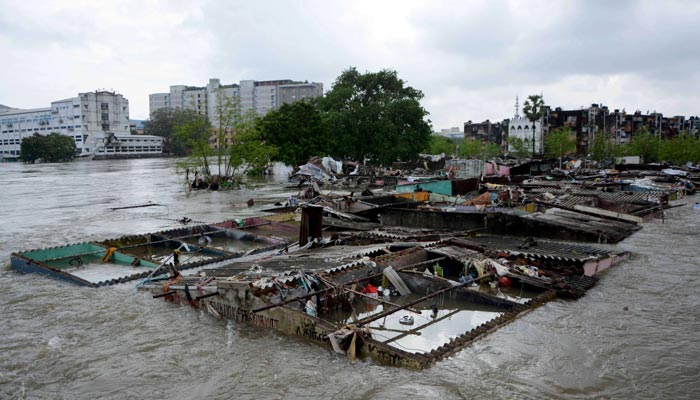A general view shows buildings inundated by floodwaters in Chennai on Thursday.
IANS, DPA/Chennai
Millions in Tamil Nadu grappled with lack of water and other basic essentials on Thursday as the heaviest rains in a century and floods left 269 people dead, thousands homeless and turned Chennai into a sea of water.
Chief Minister J. Jayalalithaa urged Prime Minister Narendra Modi to declare the unprecedented crisis a national disaster.
Modi flew into Chennai and announced Rs 10bn ($150mn) in immediate relief after an aerial survey of some of the worst hit areas. "We are all pained by the devastation," Modi said. In New Delhi, Home Minister Rajnath Singh said the situation in Chennai and three other districts was "alarming".
"It indeed is alarming," Chennai-based lawyer Elangovan told IANS, adding that thousands of people were fleeing the city that has been virtually cut off after highways and railway tracks came under water and the airport was ordered shut till December 6.
"The situation in Tamil Nadu is alarming. It is not an exaggeration to say that Chennai has turned into an island," Rajnath Singh said.
Chennai suffered unprecedented destruction, with water overflowing from rivers and reservoirs seeping into scores of apartments and houses, markets, shopping malls, offices and educational institutions, unsettling life like never before.
Though there was respite from the rains and the army, navy and air force and the National Disaster Response Force worked hard to rescue the marooned and provide relief, the water level did not show major signs of receding.
Residents complained about lack of medicines, milk, potable water, vegetables and public transport. More than 160,000 people were housed in 460 camps in Chennai, Cuddalore, Thiruvallur and Kanchipuram districts. Many thousands also shifted to others' houses after water entered theirs.
In several places, power supply and communication lines were down, adding to the misery.
"I have had no drinking water and milk since yesterday (Wednesday)," Harish Rao told IANS from his house in south Chennai.
The worst hit were the poor, tens of thousands of who live in shanties in low-lying areas. Hundreds were stranded at the railway stations. Banks advised customers to use ATMs to take out cash as some branches would not open.
Surinder Singh, a doctor from Delhi who was stuck in Chennai, told IANS: "It looks like the entire city is under one foot of water. In some places, the water level is more. Flood water has reached almost every locality, including posh areas. Everyone on the streets is barefoot."
Jayalalitha, who had a meeting with Modi, said over 4.1mn food packets were provided to people and those living in apartments in affected areas were given water bottles and food by helicopters and boats.
She said the power supply would be restored once the water was drained out of the flooded areas.
The railways cancelled 20 trains out of Chennai Central and Chennai Egmore stations and seven trains from other stations.
People in many areas opened up their homes to the distressed. Some gave away food to those marooned. Hundreds had moved to rooftops in the hope of getting food packets from military helicopters.
The Modi government has agreed to deploy 10 additional army columns and 20 NDRF teams in the state.
Chennai has been battling heavy rains since early November due to a low pressure area over southwest Bay of Bengal. The floods have also killed 54 in neighbouring Andhra Pradesh and two in Puducherry.
Floods worsened in Chennai after water was released into the Adyar river from an overflowing reservoir. Highways leading into the city have been damaged and the waterlogged international airport will remain closed until Sunday, Singh said.
At least 2,000 disaster relief and military personnel were deployed, Singh said, adding that ongoing poor weather was making relief work difficult.
Hundreds were stranded at home, food was running short and ATM machines were not working, NDTV news channel reported.
The Metereological Department predicted more heavy rainfall in the region until Saturday.
The coastal city and its hinterland have received two spells of very heavy rain in the October-December wet season, largely due to low-pressure formations over the nearby Bay of Bengal.
Over 40% of telephone connections were down and the electricity had to be disconnected in several waterlogged areas for the safety of residents, Singh said.
The floods in Chennai were caused by unregulated urbanisation and climate-change induced freak weather, Sunita Narain, director general of New Delhi-based Centre for Scienece and Environment said.
“In Chennai, each of its lakes has a natural flood discharge channel which drains the spillover. But we have built over many of these water bodies, blocking the smooth flow of water ... We only see land for buildings, not for water,” Narain said.



